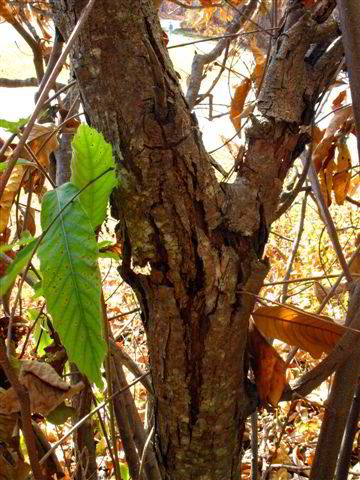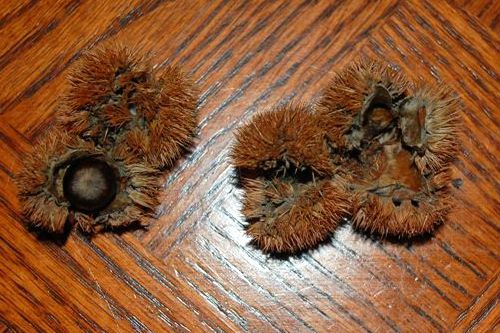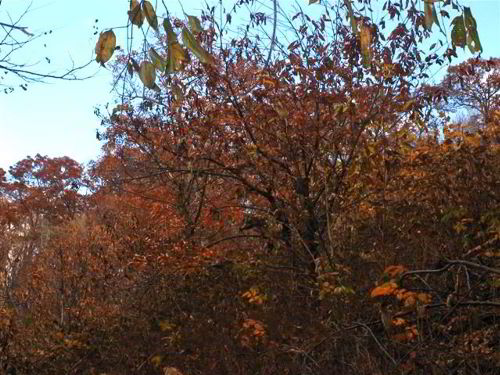|
==============================================================================
TOPIC: Chestnut Grove, Hominy Valley Overlook BRP
http://groups.google.com/group/entstrees/browse_thread/thread/89fc8c96ef52d45d?hl=en
==============================================================================
== 1 of 11 ==
Date: Sat, Nov 8 2008 10:27 am
From: James Parton
ENTS,
Last Thursday while at work Cecil Harris told me of a chestnut he
had seen on the Blue Ridge Parkway and tried to give me a rough
location of where it was at. Yesterday I went up to try to find it.
I checked two overlooks on the right and found no chestnuts but I
did find a Chinquapin ( Chinkapin ). It was the first one I had
found with nuts in years. However the shrublike tree had
considerable blight damage including cankers, dead limbs and the
tell-tell orange spots of the fungus. This tree had thinner leaves
without the lighter colored underside that I knew from the
Chinquapins in our yard from my Starnes Cove days. I have read that
open-grown trees versus forest grown ones exibit some differences.
Maybe this is one of them.
 Allegheny Chinquapin
Allegheny Chinquapin
 Chinquapin nuts
Chinquapin nuts
I found a grove of nearly a dozen chestnut trees below the Hominy
Valley Overlook at 3980ft above sea level. These may be the trees
that Cecil saw. They are located in a clearing below the overlook
among briar bushes and other weeds. Naturally this made navigating
and measuring the trees difficult. All of the chestnuts had
considerable blight damage with some having dead stems. However I
found two that had managed to bear. However among the burrs I found
no nuts. However I noticed that the attachment scars on the inside
of some of the burrs was quite large. A possible sign of viable
nuts. The fact that they are two nut bearing trees close to one
another may mean that cross-pollination could take place. I found no
nuts though. Still, critters could have carried them off.
 American Chestnut
American Chestnut
 American Chestnut
American Chestnut
I measured the sprout ring around an old root collar where an old
stump once was. It was 9ft 8 1/2in in circumference. This gives me
some idea of what size the original tree was before the blight
killed the main trunk. It was just over 3ft in diameter! The
largest sprout is 1ft 9 1/2in cbh. The tree sprout is 29.53 feet
tall. It is one of the taller ones in the grove. Another tree was
measured to 2ft 11in in girth.

The Golden Wood
On the way back home my attention was caught by a grove of bright
yellow Tulip Poplars located just above the Chestnut Cove Overlook.
I stopped, grabbing my measuring gear and camera and set out into
the woods. I first measured two of the taller tulips and took a
couple of photos. Afterwards I attempted to climb down a steep hill,
falling in the process. It sure seems that falling hurts worse as
one gets older! Stepping down into the grove was an awe
inpiring sight. The leaves were so yellow that it was nearly
eye-hurting. Among the Tuliptrees were Maples that had a tinge of
orange to them. It reminded me so much of the Golden Woods of
Lothlorien in LOTR. A truly enchanting place. My pictures did not do
the place justice. The Mallorn Trees of Lothlorien closely resemble
Beeches. Beeches like Tulip Poplar turn yellow or yellow-orange in
the fall.
The first poplar measured was 134.51 feet tall and 7 feet 11 inches
in girth. The second measured was 139.60 feet tall and 9 feet 5 1/2
inches in girth. Does anyone in ENTS have any idea of how old these
trees would be? My guess is about 100 years.
James Parton
== 8 of 11 ==
Date: Sat, Nov 8 2008 2:31 pm
From: "Edward Frank"
James,
I don't think that a fair guess could be made about the tuliptrees
without any core data from the area at all. I know farther up the
ridges along Shenandoah National Park and farther down ridge tops
along the Blue Ridge Parkway are dry ridge top forests of oaks. http://www.nativetreesociety.org/fieldtrips/virginia/shen2008/shennandoah_national_park_va.htm
One short and gnarled red oak tree, and one not really that large in
girth (around 7 feet), with many bigger ones in the same section,
had been cut after falling on the highway had 215 rings. These are
primary old-growth forests with no evidence in many of them having
ever been cut. Your tuliptrees are just a little farther down slope.
They could be young, or they could be old given the context of their
location.
Ed
== 9 of 11 ==
Date: Sat, Nov 8 2008 2:35 pm
From: James Parton
Ed,
I would love to have an increment borer and learn how to use it.
The tuliptrees don't have the deep old furrowed bark of the
Cataloochee or Joyce Kilmer old growth specimens.
JP
|